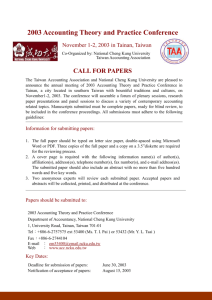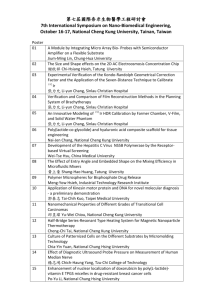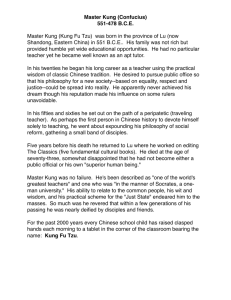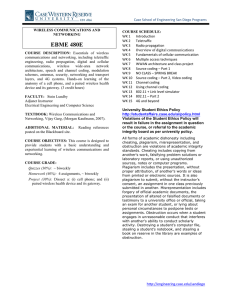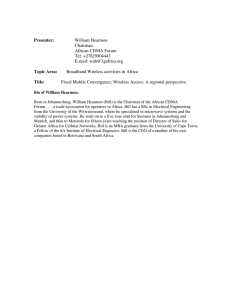Document 14519975
advertisement
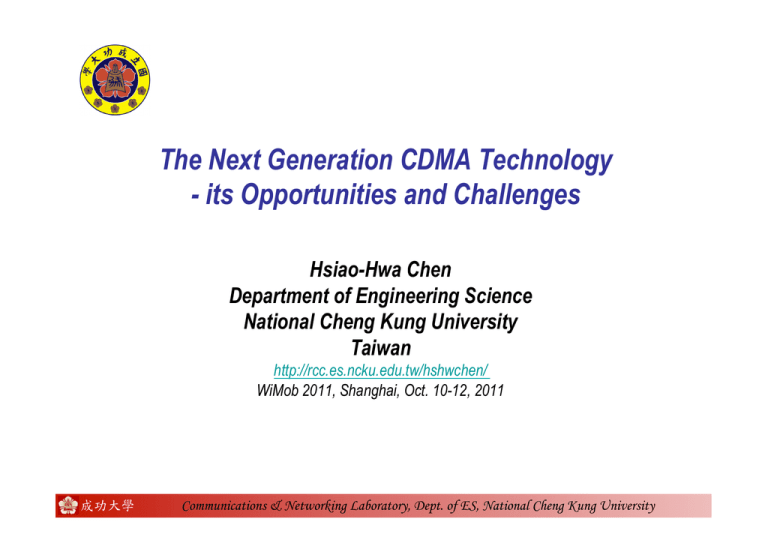
The Next Generation CDMA Technology - its Opportunities and Challenges Hsiao-Hwa Chen Department of Engineering Science National Cheng Kung University Taiwan http://rcc.es.ncku.edu.tw/hshwchen/ WiMob 2011, Shanghai, Oct. 10-12, 2011 成功大學 Communications & Networking Laboratory, Dept. of ES, National Cheng Kung University Outline ! ! ! ! ! ! ! ! Introduction Why we need NG-CDMA? What is NG-CDMA? Innovation in spreading code design Chip-level ST coding for MIMO-CDMA Doppler-resilient wireless systems Opportunities and Challenges References 2 成功大學 Communications & Networking Laboratory, Dept. of ES, National Cheng Kung University Outline ! ! ! ! ! ! ! ! Introduction Why we need NG-CDMA? What is NG-CDMA? Innovation in spreading code design Chip-level ST coding for MIMO-CDMA Doppler-resilient wireless systems Opportunities and Challenges References 3 成功大學 Communications & Networking Laboratory, Dept. of ES, National Cheng Kung University Introduction (1/4) Multiple access (MA) technology is the core of a communication system. We see the major MA technologies as follows: ! ! ! ! ! ! ! Frequency division multiple access (FDMA) Time division multiple access (TDMA) Code division multiple access (CDMA) Orthogonal frequency division multiple access (OFDMA) Spatial division multiple access (SDMA, and MU-MIMO) Interleaving division multiple access (IDMA) Opportunity division multiple access (ODMA, cognitive radio) 4 成功大學 Communications & Networking Laboratory, Dept. of ES, National Cheng Kung University Introduction (2/4) Any more MA technologies will come? ! ! ! ! May not say no, but doubt many will come. Why? The reason is there are only VERY limited ways to separate signals in some proper orthogonal spaces, by frequency (or tone), time (or interleaving), code, space, etc. That is why we need cognitive radio (also called “opportunity division multiple access”)! IPR issue has a huge impact on the evolution of MA technologies (either positively or negatively). 5 成功大學 Communications & Networking Laboratory, Dept. of ES, National Cheng Kung University Introduction (3/4) Roadmaps towards ITU IMT-Advanced (No more CDMA after 3G transitional?) Source: http://zh.wikipedia.org/ 6 成功大學 Communications & Networking Laboratory, Dept. of ES, National Cheng Kung University Introduction (4/4) Qualcomm’s roadmaps towards 4G Source: http://www.qualcomm.cn/ 7 成功大學 Communications & Networking Laboratory, Dept. of ES, National Cheng Kung University Outline ! ! ! ! ! ! ! ! Introduction Why we need NG-CDMA? What is NG-CDMA? Innovation in spreading code design Chip-level ST coding for MIMO-CDMA Doppler-resilient wireless systems Opportunities and Challenges References 8 成功大學 Communications & Networking Laboratory, Dept. of ES, National Cheng Kung University What’s wrong with CDMA? (1/3) ! Developed for voice-centric applications ! It needs long frame for signal detection. ! It suits for low-speed continuous-time transmission. ! It simply was not designed for high-speed burst-data! ! Poor orthogonality of spreading codes ! Only periodic correlation functions were considered in code design process. ! Codes are not orthogonal at all in uplink transmissions. ! Bad aperiodic correlations ! Bad partial correlations ! Only unitary codes are used, i.e., Gold, Walsh, Kasami, etc. 9 成功大學 Communications & Networking Laboratory, Dept. of ES, National Cheng Kung University What’s wrong with CDMA? (2/3) ! Low spreading efficiency (SE) in DS spreading ! SE is defined as bits deliverable per chip ! The SE for DS spreading is only 1/N bit per chip (if PG=N) ! A big room left to improve SE, which is the same as bandwidth efficiency ! Unsuitable to support QoS sensitive multimedia traffic Difficult to adjust data rate on-a-fly Data rate change always comes with the change in PG Data rate change always needs Tx power adjustment Data rate change in ONE user affects cell-wise code-assignment plan (e.g., OVSF code used in WCDMA) ! Data rate change requires huge traffic overhead ! ! ! ! 10 成功大學 Communications & Networking Laboratory, Dept. of ES, National Cheng Kung University What’s wrong with CDMA? (3/3) ! Implementation complexity ! ! ! ! Precision power control to overcome near-far effect. Multi-user detection to decorrelate user signals. RAKE for multipath signal separation and detection. Sectorized antennas to reduce co-channel interference. ! Interference-limited performance ! Multi-user interference (MUI) is a serious problem. ! RAKE receiver may not work well under mutipath interference (MI). ! Capacity is far less than processing gain (PG). ! Almost all problems come from the SAME root: Bad Codes … ! “Unitary codes” work on an one-code-per-user basis. ! All current CDMA systems use “unitary codes”. 11 成功大學 Communications & Networking Laboratory, Dept. of ES, National Cheng Kung University Outline ! ! ! ! ! ! ! ! Introduction Why we need NG-CDMA? What is NG-CDMA? Innovation in spreading code design Chip-level ST coding for MIMO-CDMA Doppler-resilient wireless systems Opportunities and Challenges References 12 成功大學 Communications & Networking Laboratory, Dept. of ES, National Cheng Kung University What is Next Generation CDMA? (1/3) ! Technological innovation from its 1G version ! Current CDMA technology is very much unitary code centric. ! Almost all existing CDMA technologies are based on onedimensional DS spreading. ! Offer interference-resistant performance ! Current CDMA systems are strictly interference-limited. ! Orthogonality among codes should be ensured in both synchronous and asynchronous transmissions. ! Code design approach should take into account real operational conditions. 成功大學 13 Communications & Networking Laboratory, Dept. of ES, National Cheng Kung University What is Next Generation CDMA? (2/3) ! Support high-speed burst-traffic ! ! ! ! ! Long-frame transmissions no long exists in B3G wireless. Gigabit all-IP wireless needs to support high-speed packet data. To detect a short packet (with only a few bits) is challenging. Spreading codes should maintain a good partial correlation functions. Enable MIMO applications ! MIMO improves performance without consuming bandwidth resource. ! Integration of ST coding and CDMA coding. ! Applications of 3-dimensional (STF) spreading codes. ! Chip-level ST coding is more powerful than bit-level ST coding. 14 成功大學 Communications & Networking Laboratory, Dept. of ES, National Cheng Kung University What is Next Generation CDMA? (3/3) ! Support rate-on-demand high-speed data access ! ! ! “Unitary codes” with DS spreading are not agile to support multi-media applications. Rate-on-demand capability should be enabled. Rate changes should not generate too much traffic overhead. ! Support Doppler-resistant wireless communications ! ! ! ! High-speed railway (HSR) communications (a mass HSR project in China). IEEE 802.11p standard for V2V and V2R communications is based on IEEE 802.11a, not designed for fast-fading channels. Military applications: missile control, air-force inter-jetfighter data links... A completely new CDMA code design paradigm is needed. ! Technically feasible to implement ! ! ! ! Precision power control should not be a necessity. Inter-code correlation should be removed at transmitter, instead of receiver, and thus MUD is not needed. RAKE receiver is not a must to achieve multipath diversity. Cell sectorization is not necessary to ease cell planning. 15 成功大學 Communications & Networking Laboratory, Dept. of ES, National Cheng Kung University Outline ! ! ! ! ! ! ! ! Introduction Why we need NG-CDMA? What is NG-CDMA? Innovation in spreading code design Chip-level ST coding for MIMO-CDMA Doppler-resilient wireless systems Opportunities and Challenges References 16 成功大學 Communications & Networking Laboratory, Dept. of ES, National Cheng Kung University Multi-dimensional spreading code design (1/8) ! Innovation in spreading code design plays an important role in development of NG-CDMA technology. ! “Real Environment Adaptation Linearization” (REAL) approach was proposed for this purpose, and it takes into account: ! ! ! ! asynchronous transmissions multipath interference random data signs in two consecutive bits Partial correlation functions ! THREE key parameters used in the REAL approach: ! ! ! ! 成功大學 K: number of users supported in a cell; M: number of element codes used by each user or flock size; N: length of an element code in chips; Thus, the processing gain of the system is defined by M✕N. 17 Communications & Networking Laboratory, Dept. of ES, National Cheng Kung University Multi-dimensional spreading code design (2/8) (a) Design scenario in traditional approach (b) Design scenario in REAL approach Comparison between (a) traditional CDMA code design and (b) the REAL Approach. 18 成功大學 Communications & Networking Laboratory, Dept. of ES, National Cheng Kung University Multi-dimensional spreading code design (3/8) The REAL Approach for DS-spreading. All possible patterns of EPACFs and OPACFs of a generic complementary code. The set size, flock size and element code length are K, M and N, respectively. (Reference: Hsiao-Hwa Chen, Hsin-Wei Chiu and Mohsen Guizani, Orthogonal complementary codes for interference-free CDMA technologies, IEEE Wireless Communications, pp. 68-79, February, 2006.) 19 成功大學 Communications & Networking Laboratory, Dept. of ES, National Cheng Kung University Multi-dimensional spreading code design (4/8) The REAL Approach for DS-spreading. All possible patterns of EPCCFs and OPCCFs of a generic complementary code. The set size, flock size and element code length are K, M and N, respectively. (Reference: Hsiao-Hwa Chen, Hsin-Wei Chiu and Mohsen Guizani, Orthogonal complementary codes for interference-free CDMA technologies, IEEE Wireless Communications, pp. 68-79, February, 2006.) 20 成功大學 Communications & Networking Laboratory, Dept. of ES, National Cheng Kung University Multi-dimensional spreading code design (5/8) 2 Hsiao-Hwa Chen, The Next Generation CDMA Technologies, 1st Edition, July 2007, 468 Pages, Hardcover, John Wiley & Sons. 21 成功大學 Communications & Networking Laboratory, Dept. of ES, National Cheng Kung University Multi-dimensional spreading code design (6/8) Important conclusions made from the REAL approach: ! The REAL approach offers a unique framework, which has showed that CDMA can be made interference-free, the most important feature for the NG-CDMA technology. ! Such an interference-free CDMA must be implemented by orthogonal complementary codes. ! The solutions to the REAL approach exist if and only if M>1. ! The number of channels accommodated in one cell is equal to the flock size of the complementary code. ! The solutions to the REAL approach exist ONLY if K=M. ! Each user employs one flock of M element codes for CDMA. 22 成功大學 Communications & Networking Laboratory, Dept. of ES, National Cheng Kung University Multi-dimensional spreading code design (7/8) b1 (t ) S11 (t ) S11 (t ) b1 (t ) USER 1 b1 (t ) S12 (t ) τ1 S12 (t ) Transmitter for a complementary coded CDMA system, where the multi-carrier modulator can be implemented by OFDM (IFFT). 2 p cos(2π f1t + θ1 ) S12R (t ) 2 p cos(2π f 2t + θ1 ) b1 (t ) S12R (t ) 2 p cos(2π f 2R t + θ1 ) b2 (t ) S21 (t ) S21 (t ) b2 (t ) USER 2 2 p cos(2π f1t + θ 2 ) b2 (t ) S22 (t ) τ2 S22 (t ) S22R (t ) 2 p cos(2π f 2t + θ 2 ) ∑ r (t ) n1 (t ) + n2 (t ) + ... + n2R (t ) b2 (t ) S 22R (t ) 2 p cos(2π f 2R t + θ 2 ) b2R (t ) S2R1 (t ) S2R1 (t ) b2R (t ) USER 2R 2 p cos(2π f1t + θ 2R ) b2R (t ) S 2R 2 (t ) S2R 2 (t ) τ2 R 2 p cos(2π f 2t + θ 2R ) b2R (t ) S2R 2R (t ) S2R 2R (t ) 2 p cos(2π f 2R t + θ 2R ) 23 成功大學 Communications & Networking Laboratory, Dept. of ES, National Cheng Kung University Multi-dimensional spreading code design (8/8) ∫ cos(2π f1t + φ1 ) S11 (t ) t = iT r (t ) ∫ cos(2π f 2t + φ1 ) ∑ S12 (t ) >0 1 < 0 −1 ∫ cos(2π f 2R t + φ1 ) S12R (t ) Receiver block diagram for a complementary coded CDMA system, where the multicarrier demodulator can be implemented by OFDM (FFT). 24 成功大學 Communications & Networking Laboratory, Dept. of ES, National Cheng Kung University Outline ! ! ! ! ! ! ! ! Introduction Why we need NG-CDMA? What is NG-CDMA? Innovation in spreading code design Chip-level ST coding for MIMO-CDMA Doppler-resilient wireless systems Opportunities and Challenges References 25 成功大學 Communications & Networking Laboratory, Dept. of ES, National Cheng Kung University Chip-level ST coding for MIMO-CDMA (1/13) ! MIMO is one of the most important technological breakthroughs for wireless communications in recent 20 years. ! MIMO provides three powerful capabilities: diversity, multiplex, and user-division, without consuming the precious bandwidth. ! All futuristic wireless systems will not be made possible without MIMO. 26 成功大學 Communications & Networking Laboratory, Dept. of ES, National Cheng Kung University Chip-level ST coding for MIMO-CDMA (2/13) The first milestone publication was published by Siavash M. Alamouti, who proposed a simple transmitter diversity scheme1, which laid a foundation for the development of later numerous MIMO applications. This scheme works based on Space-Time Block Coding, as shown in the following table: 1Siavash M. Alamouti, A Simple Transmit Diversity Technique for Wireless Communications, IEEE JOURNAL ON SELECT AREAS IN COMMUNICATIONS, VOL. 16, NO. 8, OCTOBER 1998. 27 成功大學 Communications & Networking Laboratory, Dept. of ES, National Cheng Kung University Chip-level ST coding for MIMO-CDMA (3/13) ! MIMO has become one of the most important research topics in wireless communications since Siavash M. Alamouti’s first publication on transmitter diversity appeared in 1998, as shown in this plot. Source: http://apps.webofknowledge.com 28 成功大學 Communications & Networking Laboratory, Dept. of ES, National Cheng Kung University Chip-level ST coding for MIMO-CDMA (4/13) ! Numerous space-time coding schemes were proposed for MIMO applications, including space-time block coding (STBC), space-time trellis coding (STTC), space-time differential coding (STDC), etc. ! Traditional ST coding schemes offer orthogonal signal transmissions through different antennas, to achieve diversity combining or multiplex capabilities at receivers. ! However, all well-known ST coding schemes used bit-level ST codes, whose orthogonality is extremely sensitive to multipath propagation and multi-user interference. ! Thus, naturally a chip-level space-time coding will be more robust against multipath and multi-user interferences. 29 成功大學 Communications & Networking Laboratory, Dept. of ES, National Cheng Kung University Chip-level ST coding for MIMO-CDMA (5/13) ! A few works [1][2] on spreading assisted space-time coding schemes appeared in the literature, called “space-time spreading” to separate transmissions from different antennas. However, they used traditional spreading codes which are still vulnerable to asynchronous transmissions and multipath. ! Therefore, we are motivated to find some innovative ways to design chip-level ST codes in particular for MIMO applications. [1] Bertrand Hochwald, Thomas L. Marzetta, and Constantinos B. Papadias, A Transmitter Diversity Scheme for Wideband CDMA Systems Based on Space–Time Spreading, IEEE JOURNAL ON SELECTED AREAS IN COMMUNICATIONS, VOL. 19, NO. 1, JANUARY 2001 [2] Lie-Liang Yang, and Lajos Hanzo, Performance of Broadband Multicarrier DS-CDMA Using Space–Time Spreading-Assisted Transmit Diversity, IEEE TRANSACTIONS ON WIRELESS COMMUNICATIONS, VOL. 4, NO. 3, MAY 2005 30 成功大學 Communications & Networking Laboratory, Dept. of ES, National Cheng Kung University Chip-level ST coding for MIMO-CDMA (6/13) Our approach is to generalize 1D and 2D spreading codes to 3D codes based on the REAL approach we proposed for NG-CDMA systems. ! Nf Nf Nt Nt (a) One dimensional spreading (b) Two dimensional spreading Nt Ns (c) Three dimensional spreading Evolution from 1D spreading (traditional CDMA), 2D spreading to 3D spreading ( N t : number of chips; N f : number of sub-carriers; N s : number of antennas) 31 成功大學 Communications & Networking Laboratory, Dept. of ES, National Cheng Kung University Chip-level ST coding for MIMO-CDMA (7/13) ! There are two approaches to implement orthogonal complementary coded chip-level ST coding: ! Directly use 2D orthogonal complementary codes for different antennas, namely 2D complementary coded MIMO. Disadvantage: the number of users will be limited by the number of antennas used by each user. ! Design new 3D orthogonal complementary codes for different users, each of which will use NT antennas to form an MIMO system, namely 3D complementary coded MIMO. Advantage: the number of users is not limited by the number of antennas used by each user. 32 成功大學 Communications & Networking Laboratory, Dept. of ES, National Cheng Kung University Chip-level ST coding for MIMO-CDMA (8/13) ! The 2D orthogonal complementary codes can be applied to different antennas to to implement orthogonal complementary coded chip-level ST coding, namely 2D complementary coded MIMO. ! Disadvantage: The number of users will be limited to M/NT, where M is the set size of the orthogonal complementary codes, and NT is the number of antennas used by each user. ! Advantage: Great flexibility to achieve both diversity gain and multiplex transmission simultaneously. For instance, if there are NT antennas in each user, you can group them into P groups, each of which has NT/P antennas for diversity combining, to support P independent transmissions at the same time. 33 成功大學 Communications & Networking Laboratory, Dept. of ES, National Cheng Kung University Chip-level ST coding for MIMO-CDMA (9/13) 34 成功大學 Communications & Networking Laboratory, Dept. of ES, National Cheng Kung University Chip-level ST coding for MIMO-CDMA (10/13) ! ! ! ! Multipath Rayleigh fading channel; NT, NR: numbers of transmit and receive antennas; M: number of subcarriers; K: number of users. 35 成功大學 Communications & Networking Laboratory, Dept. of ES, National Cheng Kung University Chip-level ST coding for MIMO-CDMA (11/13) ! ! ! ! Multipath Rayleigh fading channel; NT, NR: numbers of transmit and receive antennas; M: number of subcarriers; When delay is equal to nM chips, the scheme offers a better multipath resistance. 36 成功大學 Communications & Networking Laboratory, Dept. of ES, National Cheng Kung University Chip-level ST coding for MIMO-CDMA (12/13) ! ! ! Rayleigh fading channel; NT=NR=2: numbers of transmit and receive antennas; Performance curves for STBC and STTC schemes were taken from the following references. 37 成功大學 Communications & Networking Laboratory, Dept. of ES, National Cheng Kung University Chip-level ST coding for MIMO-CDMA (13/13) ! CL-ST coding provides both spatial diversity and spatial multiplex at the same time, different from traditional bit-level ST coding that only supports either spatial diversity or spatial multiplex, but not both simultaneously.. ! CL-ST coding offers MUI-resistant and MI-resistant operation for both up-link and down-link transmissions. ! CL-ST coding works based on an integrated design of ST coding and CDMA coding, offering a unique framework for system optimization. 38 成功大學 Communications & Networking Laboratory, Dept. of ES, National Cheng Kung University Outline ! ! ! ! ! ! ! ! Introduction Why we need NG-CDMA? What is NG-CDMA? Innovation in spreading code design Chip-level ST coding for MIMO-CDMA Doppler-resilient wireless systems Opportunities and Challenges References 39 成功大學 Communications & Networking Laboratory, Dept. of ES, National Cheng Kung University Doppler-resilient wireless systems (1/4) ! The NG-CDMA systems work based on 2D spreading using M sub-carriers to send M different element codes. ! A large number of orthogonal complementary codes have been generated by REAL approach. One particular type is called column-wise complementary codes, whose orthogonality is based solely on the frequency domain and is not affected by time-varying channels. ! Therefore, a NG-CDMA system based on the column-wise complementary codes is well suited for its applications in fastfading channels, such as high-speed railway communications, V2V communications, etc.. 40 成功大學 Communications & Networking Laboratory, Dept. of ES, National Cheng Kung University Doppler-resilient wireless systems (2/4) The frequency-domain orthogonality: The orthogonality is based on the sum of correlation functions of individual element codes, and thus is time-selectivity resistant. ( 2) C4×4 + + + ⎤ − + − ⎥ ⎥ + − − ⎥ ⎥ − − + ⎦ ⎡ + ⎢ + = ⎢ ⎢ + ⎢ ⎣ + + − − ⎤ − − + ⎥ ⎥ + + + ⎥ ⎥ − + − ⎦ + + + - + + - - + - - + + + + + + - + - + + è -2 è + -2 −2 + - −2 2 C(4×)4 + + + - 0 0 - - è - + è + +2 2 + +2 2 ñ 1 C(4×)4 ⎡ + ⎢ + = ⎢ ⎢ + ⎢ ⎣ + 1 C(4×)4 0 41 成功大學 Communications & Networking Laboratory, Dept. of ES, National Cheng Kung University Doppler-resilient wireless systems (3/4) Comparison of IQCCC and OVSF coded CDMA systems against time-selective and frequency-selective fading channels. We consider asynchronous multi-user transmissions with three ray multipath channel with its inter-path delay being four chips. IQCCC code set parameters: M=32, N=8, and PG=256, and OVSF code set parameters: M=1, N=256, and PG=256. The receiver uses correlator match-filter. Carrier frequency is 2 GHz, and mobility is 300 km/hr, data rate is 384 kb/s. 42 成功大學 Communications & Networking Laboratory, Dept. of ES, National Cheng Kung University Doppler-resilient wireless systems (4/4) Comparison of IQCCC and OVSF coded CDMA systems against time-selective fading channels. We consider a single-user system with flat Raileigh fading channel. IQCCC code set parameters: M=32, N=8, and PG=256, and OVSF code set parameters: M=1, N=256, and PG=256. The receiver uses correlator match-filter. Carrier frequency is 2 GHz, and mobility is 300 km/hr, data rate is 384 kb/s. 43 成功大學 Communications & Networking Laboratory, Dept. of ES, National Cheng Kung University Outline ! ! ! ! ! ! ! ! Introduction Why we need NG-CDMA? What is NG-CDMA? Innovation in spreading code design Chip-level ST coding for MIMO-CDMA Doppler-resilient wireless systems Opportunities and Challenges References 44 成功大學 Communications & Networking Laboratory, Dept. of ES, National Cheng Kung University Opportunities and Challenges (1/3) ! NG-CDMA technology was not proposed by an accident. It was developed systematically based on the optimal signature code design algorithms (i.e., REAL approach, MBGP, etc.). ! The REAL approach offers a right way to generate suitable 2D orthogonal complementary codes, making it possible to implement Doppler-resistant and/or multipath-resistant wireless systems. ! The integration of ST coding and CDMA coding leads to a powerful chip-level ST coded MIMO architecture, offering diversity, multiplex, and multi-user MIMO capabilities at the same time. ! NG-CDMA supports high-speed burst traffic required by all-IP wireless applications. 45 成功大學 Communications & Networking Laboratory, Dept. of ES, National Cheng Kung University Opportunities and Challenges (2/3) NG CDMA supports high-speed burst-traffic required by all-IP wireless applications. MI-free and MAI-free operation for a 2-user system in asynchronous up-link channels, where a two-ray multipath channel is considered with its inter-path and inter-user delays being one chip for illustration simplicity. 46 成功大學 Communications & Networking Laboratory, Dept. of ES, National Cheng Kung University Opportunities and Challenges (3/3) The challenges to implement the next generation CDMA technologies: ! The number of users K is related strictly to the number of element codes M. ! Transceiver requires an analogue multi-carrier modem with M subcarriers, whose complexity is high. OFDM may offer a possible solution, but its use of CP will degrade the bandwidth efficiency. ! Transceiver requires wide-band RF loop and antenna due to the use of DS spreading. ! Frequency-selectivity may affect the ideal correlation reconstruction at a receiver, but it offers extra user division capability exploiting channel matrix orthogonality, for further capacity enhancement. 47 成功大學 Communications & Networking Laboratory, Dept. of ES, National Cheng Kung University Outline ! ! ! ! ! ! ! ! Introduction Why we need NG-CDMA? What is NG-CDMA? Innovation in spreading code design Chip-level ST coding for MIMO-CDMA Doppler-resilient wireless systems Opportunities and Challenges References 48 成功大學 Communications & Networking Laboratory, Dept. of ES, National Cheng Kung University References (1/4) ! Hsiao-Hwa Chen, The Next Generation CDMA Technologies, 1st Edition, July 2007, 468 Pages, Hardcover, John Wiley & Sons. ISBN 978-0-470-02294-8 49 成功大學 Communications & Networking Laboratory, Dept. of ES, National Cheng Kung University References (2/4) Related Special Issues: ! Hsiao-Hwa Chen, Xi Zhang, and Wen Xu, “Next Generation CDMA vs. OFDMA for 4G Wireless Applications,” IEEE Wireless Communications (Editorial), 2007. ! Hsiao-Hwa Chen, Mohsen Guizani and Werner Mohr, “Evolution toward 4G Wireless Networking,” IEEE Network (Editorial), January/February 2007, vol. 21, No. 1, pp. 4-5. ! Hsiao-Hwa Chen, A. J. Han Vinck, Qi Bi and F. Adachi, “The Next Generation of CDMA Technologies,” IEEE Journal of Selected Areas in Communications (Editorial), VOL. 24, NO. 1, pp. 1-3, January, 2006 ! Hsiao-Hwa Chen, M. Guizani & Josef F. Huber, (2005). “Multiple Access Technologies for B3G Wireless Communications,” IEEE Communications Magazine (Editorial), vol. 43, No. 2, pp. 65-67, February 2005. ! Hsiao-Hwa Chen, Daoben Li & Qi Bi, (2005). “Emerging Multiple Access Technologies,” Journal of Wireless Communications and Mobile Computing (Editorial), John Wiley & Sons, January, 2005. 50 成功大學 Communications & Networking Laboratory, Dept. of ES, National Cheng Kung University References (3/4) Related Journal Publications: ! Ganlin Ye, Jing Li, Aiping Huang, and Hsiao-Hwa Chen, “A NOVEL ZCZ CODE BASED ON mSEQUENCES AND ITS APPLICATIONS IN CDMA SYSTEMS”, accepted for publication in IEEE Communications Letters. ! Mario E. Magaña, Thunyawat Rajatasereekul, Daniel Hank, and Hsiao-Hwa Chen, “Design of a MCCDMA System that Uses Complete Complementary Orthogonal Spreading Codes”, accepted for publication in IEEE Transactions on Vehicular Technology, 2007. ! Mohsen Guizani, Hsiao-Hwa Chen, Yu-Ching Yeh and Ming-Jiun Liu, “SPACE-TIME COMPLEMENTARY CODED (STCC) CDMA SYSTEM AND ITS PERFORMANCE ANALYSIS”, to appear in IEEE Transactions on Wireless Communications, 2006. ! Hsiao-Hwa Chen, Yang Xiao, Jie Li and Romano Fantacci, “CHALLENGES AND FUTURISTIC PERSPECTIVE OF CDMA TECHNOLOGIES: THE OCC-CDMA/OS FOR 4G WIRELESS NETWORKING”, IEEE Vehicular Technology Magazine, IEEE Vehicular Technology Magazine, vol. 1, no. 3, pp. 12-21, September 2006, http://www.ieeevtc.org/vtmagazine/index.html. ! Hsiao-Hwa Chen, Daniel Wong, and Peter Mueller, “Evolution of Air-Interface Technologies for 4G Wireless Communications”, IEEE Vehicular Technology Magazine (Editorial), IEEE Vehicular Technology Magazine, vol. 1, no. 3, pp. 2-3, September 2006, http://www.ieeevtc.org/vtmagazine/index.html. ! Hsiao-Hwa Chen, Yu-Ching Yeh, Qi Bi and Abbas Jamalipour, “ON A MIMO-BASED OPEN WIRELESS ARCHITECTURE: SPACE-TIME COMPLEMENTARY CODING”, IEEE Communications Magazine, vol. 45, no. 2, pp. 104-112, February 2007. ! Hsiao-Hwa Chen, Daniel Hanky, Mario E. Magana, and Mohsen Guizani, “Design of next generation CDMA using Orthogonal Complementary Codes and Offset Stacked Spreading”, to appear in IEEE Wireless Communications, 2006. 51 成功大學 Communications & Networking Laboratory, Dept. of ES, National Cheng Kung University References (4/4) Related Journal Publications ! Hsiao-Hwa Chen, Shin-Wei Chu, N. Kuroyanagi and A. J. Han Vinck, “An Algebraic Approach to Generate Super-Set of Perfect Complementary Codes for Interference-Free CDMA”, Wiley's Journal of Wireless Communications and Mobile Computing (WCMC), 2007, 7:605-622. ! Li-Peng Wang, Yang Yang, Hsiao-Hwa Chen, Yong Hua Song, “On the Variable Capacity Property of CC/DS-CDMA Systems”, IEEE Transactions on Vehicular Technology, vol. 55, no.3, pp. 774-778, May 2006. ! Hsiao-Hwa Chen, Yu-Ching Yeh, Xi Zhang, Aiping Huang, Yang Yang, Jie Li, Yang Xiao, Hamid R. Sharif & A. J. Han Vinck, “Generalized Pairwise Complementary Codes with Set-Wise Uniform Interference-Free Windows”, IEEE Journal of Selected Areas in Communications, VOL. 24, NO. 1, January, pp. 65-74, 2006. ! Hsiao-Hwa Chen, Hsin-Wei Chiu and Mohsen Guizani, “Orthogonal complementary codes for interference-free CDMA technologies”, IEEE Wireless Communications, pp. 68-79, February, 2006. ! Hsiao-Hwa Chen & Yu-Ching Yeh, “Capacity of a Space-Time Block Coded CDMA System: Unitary Codes versus Complementary Codes”, IEE Proceedings – Communications, vol. 152, no. 2, pp. 203-214, April 2005. ! Hsiao-Hwa Chen, Jin-Xiao Lin, Shin-Wei Chu, Chi-Feng Wu & Guo-Sheng Chen, (2003). “Isotropic AirInterface Technologies for Fourth Generation Wireless Communications”, Journal of Wireless Communications & Mobile Computing (WCMC), Wiley InterScience, John Wiley & Sons Ltd., vol. 3, Issue. 6, pp. 687-704, September 2003. ! Hsiao-Hwa Chen & Jun-Feng Yeh, (2003). ”A complementary codes based CDMA architecture for wideband mobile Internet with high spectral efficiency and exact rate-matching”, International Journal of Communication Systems, John Wiley & Sons Inc., vol. 16, pp. 497-512, 2003. ! Hsiao-Hwa Chen, Jun-Feng Yeh & Naoki Seuhiro, (2001). ”A Multi-Carrier CDMA Architecture Based on Orthogonal Complementary Codes for New Generations of Wideband Wireless Communications,” IEEE Communications Magazine, vol. 39, no. 10, pp. 126-135, October 200. 52 成功大學 Communications & Networking Laboratory, Dept. of ES, National Cheng Kung University Thank you! 53 成功大學 Communications & Networking Laboratory, Dept. of ES, National Cheng Kung University
